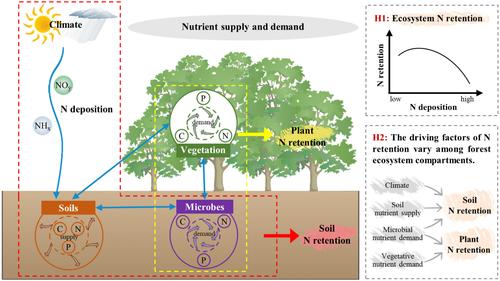当前位置:
X-MOL 学术
›
Glob. Change Biol.
›
论文详情
Our official English website, www.x-mol.net, welcomes your
feedback! (Note: you will need to create a separate account there.)
Patterns and drivers of atmospheric nitrogen deposition retention in global forests
Global Change Biology ( IF 10.8 ) Pub Date : 2024-07-09 , DOI: 10.1111/gcb.17410 Quanhong Lin 1, 2 , Jianxing Zhu 1 , Qiufeng Wang 1, 2 , Qiongyu Zhang 3 , Guirui Yu 1, 2
Global Change Biology ( IF 10.8 ) Pub Date : 2024-07-09 , DOI: 10.1111/gcb.17410 Quanhong Lin 1, 2 , Jianxing Zhu 1 , Qiufeng Wang 1, 2 , Qiongyu Zhang 3 , Guirui Yu 1, 2
Affiliation

|
Forests are the largest carbon sink in terrestrial ecosystems, and the impact of nitrogen (N) deposition on this carbon sink depends on the fate of external N inputs. However, the patterns and driving factors of N retention in different forest compartments remain elusive. In this study, we synthesized 408 observations from global forest 15 N tracer experiments to reveal the variation and underlying mechanisms of 15 N retention in plants and soils. The results showed that the average total ecosystem 15 N retention in global forests was 63.04 ± 1.23%, with the soil pool being the main N sink (45.76 ± 1.29%). Plants absorbed 17.28 ± 0.83% of 15 N, with more allocated to leaves (5.83 ± 0.63%) and roots (5.84 ± 0.44%). In subtropical and tropical forests, 15 N was mainly absorbed by plants and mineral soils, while the organic soil layer in temperate forests retained more 15 N. Additionally, forests retained more than , primarily due to the stronger capacity of the organic soil layer to retain . The mechanisms of 15 N retention varied among ecosystem compartments, with total ecosystem 15 N retention affected by N deposition. Plant 15 N retention was influenced by vegetative and microbial nutrient demands, while soil 15 N retention was regulated by climate factors and soil nutrient supply. Overall, this study emphasizes the importance of climate and nutrient supply and demand in regulating forest N retention and provides data to further explore the impacts of N deposition on forest carbon sequestration.
中文翻译:

全球森林大气氮沉降滞留的模式和驱动因素
森林是陆地生态系统中最大的碳汇,氮(N)沉积对该碳汇的影响取决于外部氮输入的命运。然而,不同森林区划中氮保留的模式和驱动因素仍然难以捉摸。在这项研究中,我们综合了来自全球森林的 408 个观察结果15 N示踪剂实验揭示了变异和潜在机制15植物和土壤中的氮保留。结果表明,平均生态系统总量15全球森林的氮保留率为63.04±1.23%,其中土壤库是主要的氮汇(45.76±1.29%)。植物吸收了 17.28 ± 0.83% 15 N,更多分配给叶(5.83±0.63%)和根(5.84±0.44%)。在亚热带和热带森林中, 15氮主要被植物和矿质土壤吸收,而温带森林的有机土层保留较多15另外,森林保留量多,主要是由于有机土层保留能力较强。其机制15不同生态系统区划的氮保留量各不相同,整个生态系统15氮保留受氮沉积影响。植物15氮保留受到植物和微生物养分需求的影响,而土壤15氮保留受气候因素和土壤养分供应的调节。总体而言,本研究强调了气候和养分供需在调节森林氮保留方面的重要性,并为进一步探讨氮沉降对森林碳汇的影响提供了数据。
更新日期:2024-07-09
中文翻译:

全球森林大气氮沉降滞留的模式和驱动因素
森林是陆地生态系统中最大的碳汇,氮(N)沉积对该碳汇的影响取决于外部氮输入的命运。然而,不同森林区划中氮保留的模式和驱动因素仍然难以捉摸。在这项研究中,我们综合了来自全球森林的 408 个观察结果15 N示踪剂实验揭示了变异和潜在机制15植物和土壤中的氮保留。结果表明,平均生态系统总量15全球森林的氮保留率为63.04±1.23%,其中土壤库是主要的氮汇(45.76±1.29%)。植物吸收了 17.28 ± 0.83% 15 N,更多分配给叶(5.83±0.63%)和根(5.84±0.44%)。在亚热带和热带森林中, 15氮主要被植物和矿质土壤吸收,而温带森林的有机土层保留较多15另外,森林保留量多,主要是由于有机土层保留能力较强。其机制15不同生态系统区划的氮保留量各不相同,整个生态系统15氮保留受氮沉积影响。植物15氮保留受到植物和微生物养分需求的影响,而土壤15氮保留受气候因素和土壤养分供应的调节。总体而言,本研究强调了气候和养分供需在调节森林氮保留方面的重要性,并为进一步探讨氮沉降对森林碳汇的影响提供了数据。











































 京公网安备 11010802027423号
京公网安备 11010802027423号